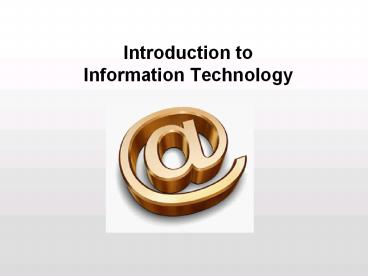Introduction to Information Technology - PowerPoint PPT Presentation
1 / 20
Title:
Introduction to Information Technology
Description:
Introduction to Information Technology SWC1 What is information? We all know that but what is it really? In the context of Information Technology, we often talk ... – PowerPoint PPT presentation
Number of Views:765
Avg rating:3.0/5.0
Title: Introduction to Information Technology
1
Introduction to Information Technology
2
What is information?
- We all know thatbut what is it really?
- In the context of Information Technology, we
often talk about data - For a computer, data is always just a sequence of
0s and 1s, like - 00100101010101111010010110101101
- It is us as human beings, that interpret the data
within some context - By this interpretation, data becomes information
3
What is information?
- In order to transform data to information, we
need a context within which to interpret data - In one context, 00101010 might mean the number
42 - In a different context, 00101010 might mean the
letter C - Data Context Information
4
Information and communication
- So what is the purpose of all this information we
produce? - Ultimately, the purpose of all this information
is communication, in a broad sense - Communication with yourself
- Communication with others
- Communication with a computer
- Communication over distance
- Communication with the future
5
Humans like to communicate
- The ability and desire to com-municate is a
very strong trait for humans beings - Without communication, it is very hard to
- Cooperate in solving complex tasks
- Transfer knowledge to others
- Develop a culture
- At a certain stage we need tech-nology to
communicate effectively
6
Historical IT
- This is also IT generally speaking
7
Historical IT
- The more advanced a civilisation becomes, the
more it requires sophisticated IT - Major milestones in pre-computer IT
- Language (where??, when??)
- Writing/alphabet (Middle East, ca 3000 b.c)
- Postal service (Roman Empire, China, ca 0)
- Printing (China, ca 600)
- Wire telegraph (Europe, ca 1800)
- Radio (Europe, ca år 1900)
8
Who came first?
- So you may wonder
- Does our civilisation become more advanced,
because we are becoming better to com-municate? - Or
- Are we becoming better to communicate, because we
need it to advance our civilisation?
9
History of computers
10
The computer way back
- First mechanical computers were built in ancient
Greece around year 0. - The Antikythera device was a mechanical device
for predicting astronomical phenomena - It was not a programmable device
- Similar machinces are built in the Middle East
about 1,000 years later - More complex machines do not really emerge before
around year 1800
11
The computer 19th century
- In 1801, Joseph Jaquard construcs a mechanical
loom, which could be programmed using punch cards - First programmable device
- Programmable You can change the behavior of the
machine, without changing it physically
12
The computer 19th century
- British Charles Babbage designs the first
generally programmable device (called the
Analytical Engine), in mid-19th century - Would in principle work as a modern computer,
even though it was a purely mechanical device - Development was funded by the British gover-ment,
but it was shut down
13
The computer 19/20th century
- For administration of the 1890 US census, a
machine based on punch cards is constructed - Still a purely mechanical device
- The device is constructed by Tabulating Machine
Company, which later becomes...IBM - During the start of the 20th century, more
advanced mechanical devices are constructed - Technology for building electronic computers is
emerging
14
The computer 1940s
- First electronic computers emerge during the
period 1940-1945 - Development highly driven by World War II
- British computer for breaking German codes
- American computer for calculation of misslie
trajectories - Shortly after the war, the architecture of a
modern computer is designed (the von Neumann
architecture)
15
The computer 50/60/70s
- A market for computers is emerging in the
business sector - First to adopt computer technology are banks,
insurance, and other computationally heavy
businesses - IBM initially has a very large market share, but
other companies begin to emerge - First home computers emerge in late 70s
16
The Computer 80s
- Computers find their way into private homes
- Very little software initially primarily used
for games - IBM markets the IBM Personal Computer in 1981
- Is the basis for modern PCs
- Price was about 8000
17
The computer 90s
- Number of PCs in private homes explodes
- Prices becomes reasonable
- Much easier to use (Windows, Mac)
- Much more software
- Internet / WWW takes off
- Also some transition in the industry from central
machines (main-frames) to networks of PCs - Internet euphoria in 1995-2000
18
The Bubble
19
The computer 00s
- Almost full penetration of PCs in homes, at
least in the western world - Internet more important than the computer itself
- Internet access spreads to other devices than
traditional com-puters (phones, PDA,) - User-driven content on the Web (web 2.0)
20
The computer 10s
- Even more internet-enabled devices (tablets,
Smart-TV,) - Traditional PC platform stalling
- Web 3.0 (Intelligent Agents, web creates
knowledge) - and who knows what else?































